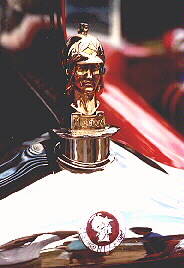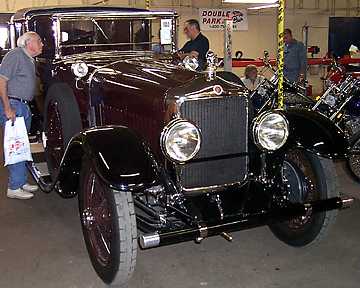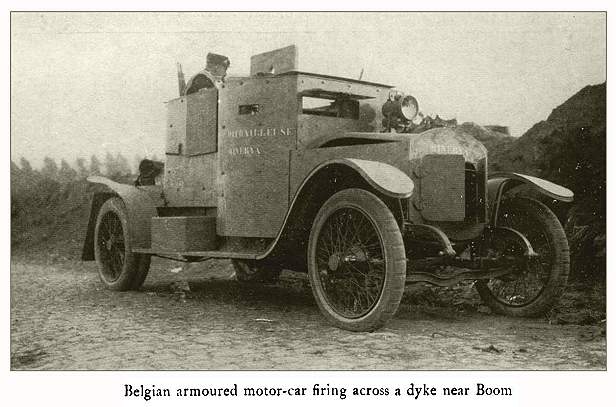|
|
|
|
By 1911, Societe Nouvelle Minerva S.A. had become Belgium's largest manufacturer, employing 1600 people. Sold as "The Car Of Kings and Queens" Minervas were bought by the rich and famous all over the world. Customers included King Albert and many Hollywood stars. These vehicles had large 5.9 and 6.3 liter engines and were gorgeous machines. They were considered to be in the same class as Rolls Royce and Mercedes. The Army of Belgium was quite to the forefront when it came to motorization before 1914, and they were the first to field Armoured Cars in any quantity. From the beginning of the war they used Machine Gun equipped motor cars in combat, and already from mid-august many of them were equipped with armour plating, of some 5mm thickness. Most of these were based on a standard motor car, model 38CV with a 4 cylinder engine, manufactured by the Antwerp firm of Minerva. (The only modification was that the standard single back wheels were substituted for double ones.) The vehicle was open-topped, lacked entry doors - the crew had to climb in and out over the sides. Later marks - produced from 1916 - had the fighting compartment fully enclosed. The total weight was some 4 tons, the maximum speed some 40 km/h. Some 25-30 vehicles of model 1914 were built, until the Minerva Factory was overrun by the Germans in October 1914. This AFV was basically sound, and the last vehicles were not withdrawn from the Belgian Army until 1935! The German Army used four captured Minervas, and some of them were employed in the invasion of Rumania. During the 1920s Minerva was producing over 2,000 cars a year with the majority being sold in Britain. By 1928, the luxury car market was declining as more technically advanced American cars emerged. In 1930, Minerva introduced the AL - an eight cylinder, 6616cc capable of producing 40 horsepower, however this car was not a success. As sales continued to slide, Minerva decided to merge with Belgium car manufacturer, Imperia, in 1936. Imperia had been making cars since 1906. Imperia was one of the first manufacturers to offer a sliding sunroof on their cars. As the great depression swept through Europe, all car makers were having a tough time. By 1934, Minerva/Imperia was down to one model under contract, a four wheel drive Adler with Belgian coachwork. With the start of WW II, Minerva was out of cars and agreed to build under license for the Standard Motor Company. The Vanguard was soon being assembled in Belgium. Aware of the Belgium army's search for a new lightweight four wheel drive vehicle, the head of Minerva, approached the Rover company in the spring of 1951. On the June 21st Rover learned that a total of 2500 vehicles would be built. In May of 1952, a deal was made where Rover would supply full technical assistance to Minerva who would manufacture Land Rovers under license. Rover would supply kits consisting of a chassis, engine, axle, transmission and other parts to the Minerva company in Antwerp who would then build a steel body to suit the Belgium army. The Minerva assembly line employed about 500 workers who could produce 50 vehicles a day. These vehicles were left hand drive, 80" wheelbase models, with a 2 liter engine. The bodywork, including the doors, was all steel and a narrow front grille was used with the Minerva badge. An armored assault vehicle version was also produced with heavy plating, armored glass and machine gun mounts. In 1954, a new 86" version was introduced. This vehicle was produced for the next three years, until 1956 when all contracts between Minerva and Land Rover were terminated. Only 1,100 of these vehicles were produced. The Minerva and Rover deal ended in September 1954 when Minerva sued Rover for breach of contract. Later that year Minerva introduced a C-20 and M-20 (Civilian and Military) all terrain vehicle, but very few of these are believed to have been produced and the company soon experienced financial difficulties. These vehicles were capable of climbing slopes of 70 degrees could seat nine people. They did not prove popular with the Belgian army who continued to purchased Land Rovers direct from Rover. The Minerva company finally went bankrupt 1958, however many of these rugged military vehicles can still be seen traveling the back roads of Europe. It has been said the only way to destroy a Minerva is to saw it in half. The car which started as a luxury "Goddess of the Automobiles" ended being quite the rugged warrior. Sylvain de Jong certainly picked the right name for his bicycles. |
||||
 |

|
|||
|
|

|
|||